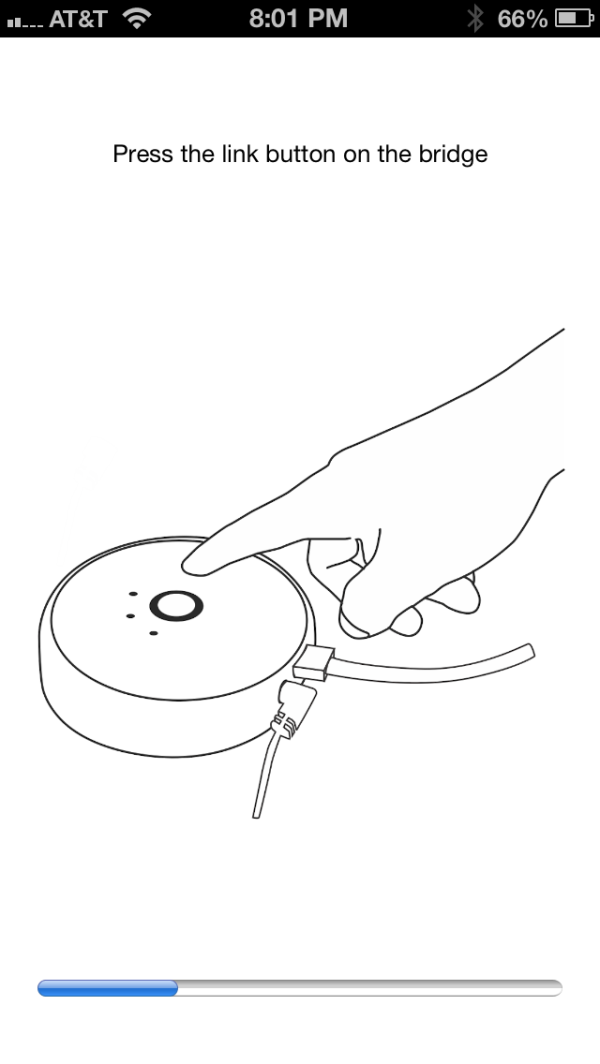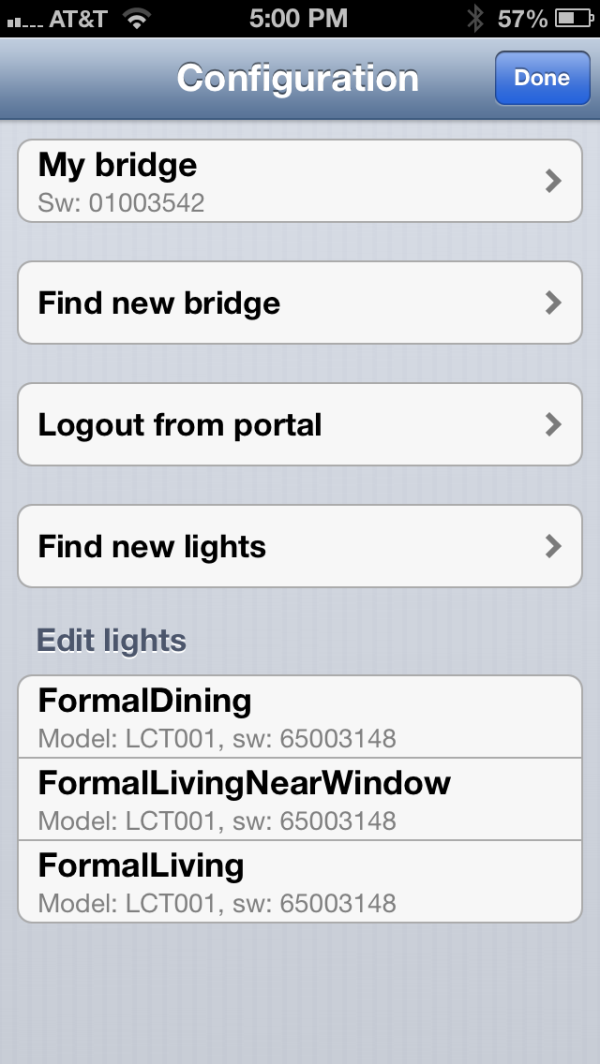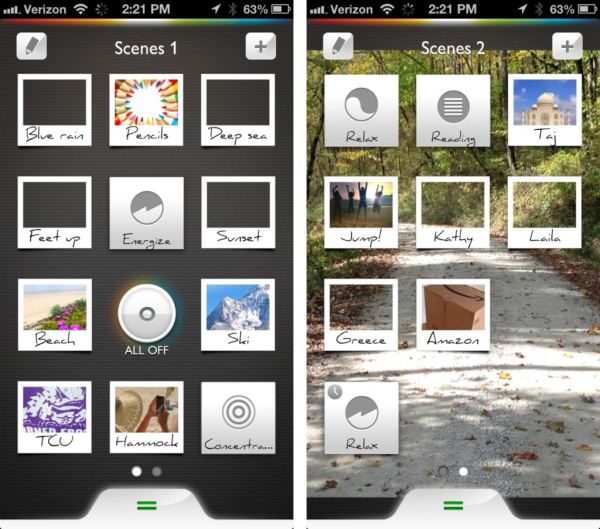Philips Hue: Automated Home Lighting Gets Colorful
by Ashu Joshi on March 1, 2013 12:50 AM EST- Posted in
- Gadgets
- Home Automation
- Philips
- Hue
- Lighting
Philips Hue Setup
The setup process is very easy and at no point do you need a PC or a Mac computer—everything can be done using a Smartphone or a Tablet. The first step for any automation controller that can be controlled over the Home Network or Internet is to get it on the Network, naturally. Philips makes this easy by sticking with Ethernet for the Hue Bridge.
As far as the setup procedure, the first step is to screw in the Connected Bulbs and turn them on. All the bulbs turn on just like normal light bulbs, with a default white light. Once all the bulbs are screwed in and powered on, plug the Hue Bridge into an Ethernet port connected to your home router/gateway and apply power.
The Hue Bridge boots in less than 20 seconds (you can see the boot process in this short video). The next step is to install the app from the Apple App Store on your iOS device (or the Google Play Store for Android).At this point, make sure that your smartphone WiFi is on and connected to your home network. Fire up the app and it will instruct you to press the “link” button on the controller. When you press the button the app discovers the Hue Bridge and you should be ready to go. In my case, it automatically discovered all the three bulbs and they showed up in the app.
From the App settings section it’s possible to rename each bulb to give it a meaningful location. To help with this process, when you select one of the bulbs in the app the corresponding physical bulb starts blinking to show you which light you’re adjusting. This is a handy feature for the initial setup, and it could be even more important if you happen to have a lot of Connected Bulbs.
The app comes with multiple scenes that set the lighting ambience to predefined levels. You can also snap a photo and let the app decide on the appropriate color(s), and you can save all of these settings to new “scenes” (e.g. you might have one setting for a regular dinner with a different settings for a “romantic dinner”). There is also an option in the app to add more Bridges or bulbs, but I have not been able to try that yet. It seems pretty straightforward: adding a new bulb takes you to a page on the Smartphone that instructs you to screw in the new light, turn power on, and start the search.
It’s also possible to control Hue from more than one device (e.g. a tablet, a phone, and maybe the phone of a significant other). The process is as before: download the app, make sure you are on the home network (WiFi), fire it up, and when the app prompts press the “link” button on the Hue Controller and it is paired to the network. (This works very similar to the Sonos app as well.) If you have edited the names of the bulbs (for example I called one of them “FormalDiningLamp”), the other devices will pick up the names as they’re all stored in the Hue Bridge (so thankfully you only have to input the names once).
Controlling the Bridge locally is pretty simple, but if you want to be able to manage the lighting when you’re not at home (e.g. you’re not connected to your home network), you’ll need to create an account on MeetHue.com. Select the “Login to portal” option within the app and it will open up a browser with the account creation page. The page is clearly designed for phones and tablets and after a few guided steps you should be all set. Once you confirm whether you’re using a smartphone or a tablet you can then control the lights from anywhere with Internet access (provided of course that your home network stays up).













94 Comments
View All Comments
CeriseCogburn - Monday, March 4, 2013 - link
I didn't see any whining and complaining about LUXURY item or product ?!What's going on here ?
Did our usual crybaby posting crew defer their usual stank to a knee jerk reflexive Apple muzzle worship ? I doubt that - maybe they just brainfarted out.
glugglug - Monday, March 4, 2013 - link
The extra weight is normal for LED lights, programmable or not, as LEDs don't work as well when they get hot, so LED light bulbs have hefty heatsinks.A decent LED bulb goes for $30-$40, especially if you try to get a warm white close to incandescent color instead of the typical painful bluish, so $60 for color adjustable LEDs is actually quite reasonable.
In areas like NYC where the ConEd prices are highway robbery at face value, and they multiply that by claiming you use several times more than you do, a $60 LED bulb can pay for itself in 2 months if you use it 24-7.
wiyosaya - Monday, March 4, 2013 - link
Philips was already in home automation before this with their Pronto remotes. They got out of that due to lack of profitability a bit over a ago year now.While home automation is nice, I personally do not see the need for lights that change color. For people who experience seasonal affective disorder, this package might be the worst thing that they could do for themselves as "daylight" light sources are the best for them.
IMHO, the changing color aspect is marketing bling that Philips is adding to a high-priced product to market it to the masses. As I see it, the price of this product resides in the cost of the LED lights. One might be able to find a simpler and lower cost home automation starter kit, and then put LED bulbs in where they make sense - this approach, however, would abandon the changing color LEDs which may be of little use to most people anyway other than for novelty uses.
glugglug - Tuesday, March 5, 2013 - link
1. Instead of the LED approximation of a standard light bulb (which they do poorly due to the heatsink affecting the form factor), make the bulbs available in PAR30 or other PAR form factors, which LEDs exel in, and which is typically used for recessed ceiling lighting for a greater effect on room ambiance.2. Provide an API for controlling them which can be integrated into an Windows audio filter driver or WMP visualization for the full disco effect.
If both of those were in place, I'd probably get 15 of the bulbs for my basement.
shriganesh - Thursday, March 7, 2013 - link
What a nice and detailed and clean article! Thanks a lot Ashu Joshi! Keep up the great work. I never thought of the neighbor's commands interfering with ours!sotoa - Thursday, March 7, 2013 - link
Can these be used outside? Like to light up the front porch? For example, I can see changing the lights to Green for St. Patrick's Day, or Orange for Halloween, etc. What do you think?Are these bulbs equivalent to a 60 watt incadescent? I wasn't quite clear on that.
Velocialume - Thursday, March 7, 2013 - link
So this is the third review I've read for the Hue system.. I'm about to purchase it, but I can't seem to find confirmation that you can in fact, have the bulbs cycle colors autonomously. I really like the idea of having a sort of dreamscape type room with each bulb gradually changing color every few minutes.Either I'm blind or inattentive, but I haven't seen this feature mentioned in any review. Is this possible?
Ualdayan - Monday, March 11, 2013 - link
While I researched them like you are doing (I went ahead and ordered some btw) I found that they basically respond to HTTP POST commands (that's what he meant by open source). That means a simple javascript running on one of your computers could cycle through the different colors on all the lights for you. Take a look at every hue for ideas. (Funky comment system claimed it was spam when I tried to type the URL in an easily clickable link for you)mgc8599 - Tuesday, March 12, 2013 - link
The power consumption figures seem incorrect to me. Kill-A-watt is showing current reading as 0.08 to 0.09 amps so the power draw should be (0.08*110=8.8 w or 0.09*110 = 9.9 w) and not 5.4 w which gives 60 to 67.5 volts. also in off state the power draw will be (0.01*110=1.1 w or 0.02*110=2.2 w) and not 0.4 w as written because it gives 20-40 volts.random2 - Thursday, March 14, 2013 - link
"...they’re quite a bit heavier than a typical light bulb. Most likely the added weight comes from the controller and antenna necessary to talk to the network, and possibly the addition of multi-colored LEDs adds a bit as well..."If this has already been posted in the comments my apologies.
I believe these are heavy in part because household 120v current needs to be stepped down to a DC supply for these LED lamps. meaning each lamp has a transformer.